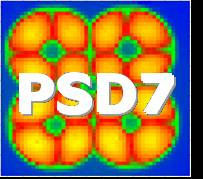Speaker
Dr
Johannes Treis
(MPI Munich)
Description
Two dimensional back-illuminated (500 µm sensitive thickness) X-ray
pixel detectors with pixel sizes from 36 µm, 51µm, 75 µm to 150 µm
have been developed for applications in X-ray astronomy (0.1 keV to
20keV) and for wave front sensing in adaptive optics systems up to 1
µm wavelength in the NIR. In both applications the environmental
conditions are such that operation at ``warm temperatures´´ around
-30o to -10o C is highly desired simultaneously to high readout
speed and low noise operations. During our tests with device formats
of 64×64 to 264×264 frame rates of up to 1.000 per second have been
achieved with noise floors of 2.5 electrons (rms). For temperatures
around - 20o C single stage Peltier cooler can be used, making the
system compact and easy to use. The achieved energy resolutions with
a pnCCD in the full imaging mode was 210 eV (FWHM) at the MnKá –
line at 5.9 keV at - 100 C and with 75 µm pixels and a format of 256
× 128 being read out at 200 frames per second. The active pixels
sensor DEPFET achieved at the same temperature with the same pixel
size but with a format of only 64 × 64 and 300 frames per second an
energy resolution of 150 eV only. pnCCD for wave front sensing with
a format of 264 × 528 were operated at 1.000 frames per second and a
noise of less than 3 electrons at - 400 C. The full set of
measurements will be shown to taste the comfortable parameter space
for applications in heaven and on earth.
Primary author
Prof.
Struder Lothar
(Max-Planck-Institut für extraterrestrische Physik)
Co-author
Dr
Johannes Treis
(MPI Munich)
